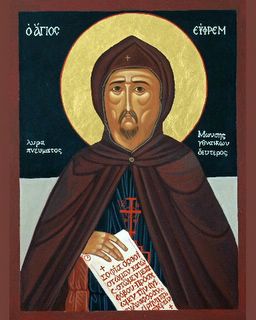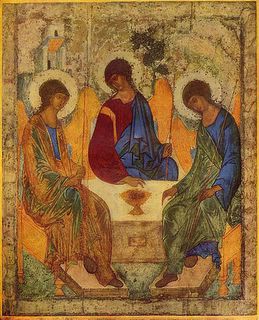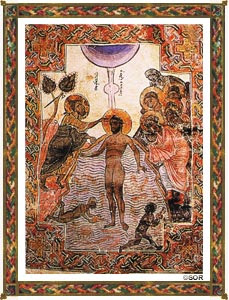Mission Overview w LINKS
Welcome to St. Ephrem Mission
Our Links to:- Church and Calendar Links;
- Notes on St. Ephrem the Syrian;
- IOC News, Seminary Life;
- Christology, Ecclesiology, Ecumenism,
- Liturgy, Icons, Ministries
Patron of the Our Mission

Icon of Our Holy Father Ephrem
written by the hand of KhouriaHeather
The script on the left:
Harp of the Spirit
and on the right:
Second Moses to Womankind
Notes on Ephrem the Syrian
Ephrem's 3 Harps
Ephrem of Nisibis in the Church's liturgy and history
with more Resource LINKS updated 2010
Eprhem on Eucharist: Qurbana as Living Medicine, Metanoia, Mystagogy
Griffith, Modern Theology
Ephrem on Eucharist: Pentecost - Qurbana - Church
Griffith, Modern Theology
Ephrem of Nisibis in the Church's liturgy and history
with more Resource LINKS updated 2010
Eprhem on Eucharist: Qurbana as Living Medicine, Metanoia, Mystagogy
Griffith, Modern Theology
Ephrem on Eucharist: Pentecost - Qurbana - Church
Griffith, Modern Theology
Christ and Church:koinonia, metanoia, theosis
liturgical and iconographic styles
Ecclesiology and The Catholica
liturgical and iconographic styles
Ecclesiology and The Catholica
God's creation of the human person as being in God's image is the place to begin for our understanding of the idea of the term "people of God."
excerpt:
- The concept "people of God" is based primarily on biblical presuppositions and a patristic understanding of ecclesiology. The people of God is the pleroma of the church; quahal, the congregation of God's people.
- The history of Israel is the history of the people of God, seen particularly in God's promise to Abraham and the covenant made with Israel on Mount Sinai.
- The creation of the Church by the Incarnate Logos of God established a new relationship with God's people that draw into the covenant all races and all human persons.
- Orthodox Ecclesiology: Understanding the Church through Christology and Pneumatology From an Orthodox perspective, the Church is both catholic and local, invisible and visible, one and many...
The grace of the Trinity is the starting point for understanding the nature of the Church, and especially for her unity in multiplicity, as the Holy Spirit shares one life and one being. ...
How does the Church participate in God's mystery and grace? ...
The answer ...is in and through Christ.
Oriental Orthodox Wiki-info
Christology in the Oriental Orthodox and Eastern Orthodox Churches
Heavenly Liturgy: Hymns of the Seraphim, Eternal Praise, Liturgy as Icon
Patristics: Syriac Typology see also page sidebar links:
"Qurbana-Qurbono
re Naming the Mysteries"
"Rabbula Gospels and Syriac Scripts"
"Syriac to Aramaic re West-East"
"Korban, Exodos to Pesaho-Pascha"
"Syriac Hymns
re Madrasha - Memre
vis-a-vis
Byzantine Kontakia"
re Naming the Mysteries"
"Rabbula Gospels and Syriac Scripts"
"Syriac to Aramaic re West-East"
"Korban, Exodos to Pesaho-Pascha"
"Syriac Hymns
re Madrasha - Memre
vis-a-vis
Byzantine Kontakia"
Syriac Teaching Songs: catechetics and mystagogy
"fides quaerens intellectum"
vis-a-vis
"fides adorans mysterium":
vis-a-vis
"fides adorans mysterium":
a Syriac "Phenomenlogy of Disclosure"
the Mystery-Symbol called "raza (sing.), raze (plur.)":
as anamnesis and eccelsiology ~
living kerygma re Eschatological Fulfillment
christology + pneumatology
living kerygma re Eschatological Fulfillment
christology + pneumatology
Eccelsiology and Ecumenism
FOCUS: fellowship of orthodox christians united to serve. FOCUS home page
IOCC: International Orthodox Christian Charities
The Eastern Christian Churches
7th ed, Fr. Ronald Roberson: excellent info ONLINE TEXT
Assyrian Church of the East | Oriental Orthodox Churches | Eastern Orthodox Churches | Catholic Eastern Churches | Ecumenical Relations
Info LINKS: Oriental Churches
Indian Coptic Syrian Armenian Ethiopian Eritrean
More Ecumenical Resources
Ecumenical Notes FYI
Ecclesiology and Liturgy Resources
and in spanish: "Eclesiología católica y eclesiología ortodoxa"
Heavenly Liturgy
and
the Liturgical Year:
and
the Liturgical Year:
Christology,
Icons,
Eccelsiology
and
Ecumenism.
Icons,
Eccelsiology
and
Ecumenism.

LITURGICAL SEASONS:
The Liturgical Calendar as a Theology of Seasons and Scripture
Calendar and Scripture Readings
News - Events
of the
of the
Armenian, Coptic, Eritrean,
Malankara, Syrian
and
Eastern Orthodox Churches
and
Eastern Orthodox Churches
On The Street, the Gift Of Life
On The Churches, the mission to be one in Christ:
Let us pray for one another
remembering Cairo and Alexandria,
Aremnia and Tripoli, Mogadishu,Rwanda,
Kosovo, the Congo, Ivory Coast,
Let us never forget
The Holodomor and The Shoah ~
Let us always see
everywhere
about us
and
within us
the womb of Christ
+
THEOLOGICAL DIALOGUE: ROMAN CATHOLIC AND ORIENTAL ORTHODOX CHURCHES Rome: Jan 25-28, 2011
VIDEO 2010: Theological Dialogue between the Roman Catholic Church and the Oriental Orthodox Churches
Photos in links above and below
Benedict XVI greets Orthodox Brothers in Christ
occasional traditionalisms, but usually reliable
Indian Orthodox Christian News
IOC North America:
Northeast Clergy Retreat 2010
Eastern USA Regional Conference 2010
The NorthWest USA Regional Conference 2010
More Info: CHURCH CALENDAR
Calendar Origins West and East
excerpt courtesy Shroro Syriac Orthodox Christian Digest:
How a Syriac Patriarch assisted the Gregorian Calendar's development
by way of Syrian monk librarians
helping Muslim scholars
to read Greek geometry
and the mathematics of Egypt and India...
The original 9 member commission to reform the Julian calendar under Pope Gregory XIII:
by way of Syrian monk librarians
helping Muslim scholars
to read Greek geometry
and the mathematics of Egypt and India...
The original 9 member commission to reform the Julian calendar under Pope Gregory XIII:
Christoph Clavius, German Jesuit
Cardinal Sirleto,
Cardinal Sirleto,
Vincentius Laureus Bishop of Mondovi
Antonio Lilius (Giglio) doctor of medicine
Petrus Ciaconus
Seraphinus Olivarius, Vatican jurist
Ignatius Dantes, Dominican friar (Ignazio Danti) and map maker
Teofilus Martius, Benedictine monk
and ...
Ignatius Nemet Allah I, Syrian Orthodox Patriarch
Antonio Lilius (Giglio) doctor of medicine
Petrus Ciaconus
Seraphinus Olivarius, Vatican jurist
Ignatius Dantes, Dominican friar (Ignazio Danti) and map maker
Teofilus Martius, Benedictine monk
and ...
Ignatius Nemet Allah I, Syrian Orthodox Patriarch
CHANT
Chant Resources at Malankara Indian Orthodox Church website
and
Chant resources at Mar Gregorios Orthodox Christian Student Movement of All America and Canada
Syriac Treasury of Chants: Beth Gazo d-ne`motho
with links to the syrian modal system
see also: Guide to the 8 Modes and this link for examples: SyriacMusic.com
Feasts
of the Church Year
of the Church Year
Beginnings
Beginning the Church Year of Feasts: an Advent of the ParousiaChrist in the Spirit in the Church
The Festal Calandar: an Apocalypsis of the Beginning and the End
The Church Year as a typos of Pentecost and The Kingdom
Sanctification Sunday and the Mysteries of the Kingdom
Dedication Sunday and the Catholica
Nativity Season
New Year's Day and The Eighth Day, A.D. 2009
Epiphany and Theophany
Theophany: Cosmos - Temple - Communio
Great Lent: Our Journey in His Baptism: the Revelation of the Waters of Theophany
Re-Turning to Great Lent, 2009
Paschal Season: Christ Our Pasch
March 25: Annuciation and Ecclesia Orans
- Ephrem on the Feast, Mary's fiat and Pentecost,
- The Qurban of Christ in the Spirit in the Church:
- Ecclesia Orans and the Mysteries of the Eighth Day
The Easter Journey: a Liturgical Parousia of the Kingdom
Resurrection 2010 AD
Pascha 2009: Go to Gallilee, where you will see Him as He promised!
Ascension of the Lord
Pentecost, the Feast of the Church
Pentecost 2010 AD
Pentecost 2009 AD
Pentecost re. The 8th Day
Pentecost: Ascension to Epiclesis and Parousia
Pentecost and the Heavenly Liturgy of the Church:
Notes from Fr.B.Varghese "West Syrian Liturgical Theology":
Pentecost and Eschaton: A Cloud of Wintesses"
Pentecost: In-Gathering One Catholic Communio in Christ
Pentecost: The Diptychs and The Last Things
Transfiguration and Translation
Transfiguration: Midsummer Vision of the Feast, The Icon, and the Journey upon the Holy Mountain
Transfiguration: Epiphanic Light
The Taboric Light as 4 Dimensions of the Eighth Day:
- discipleship and beatitudes
- communio and theosis
- mystagogy and mysterion
- sanctus and gloria
Transfiguration Tradition: St. Makarios and Macarian Themes
Endings
2010: Dormition and Translation of Theotokos, Assumption of Virgin Mother, Ascension of St. Mary2009: Ascension of St. Mary
7 Sundays of the Holy Cross
Holy Cross: The Crown of the Calendar Year and Salvation History in Christ
NEW links re Indian Orthodox Sacred Art:
of the Malankara Orthodox Church,
under leadership of His Grace Dr Thomas Mar Athnasius Metropolitan.
The School aims at developing an Indian system of iconography
as well as promoting icons in the entire Malankara Church.

Ethipiopian and Coptic Sacred Art
Earliest Illustrated Bible Found In Ethiopian Orthodox Monastery
See more Ethiopian sacred art here
and coptic sacred art here
and more coptic sacred art at the LA Coptic Diocese here
and this Coptic page with extensive links
See also various Coptic church images
and this page from the Coptic Monastery of The Holy Virgin
Seminarian News:
Blessings upon our 2008 Graduating Seminarians Graduation Photos and links to the Theological Programs for our seminarians at St. Vladimir's Seminary and St. Tikhon's Seminary.
New Site:
His Grace was accompanied by Dn. Gabriel from Spokane, WA. Formerly a faculty member, Eusebius Thirumeni has been for part of our seminary for a long time -- since its inception. He also held the position of Bursar and played a critical role in the growth of our seminary from its beginning.
Recent Site Visits
from Around the World
from Around the World
note:
green dots indicate 10 visits
white dots indicate 10+ visits








